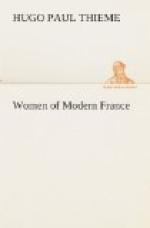Among the social salons, the finest was the Temple of the Prince de Conti and his mistress, the Countess de Boufflers. It was a salon of pleasure, liberty, and unceremonious intimacy; his thes a l’anglaise were served by the great ladies themselves, attired in white aprons. The exclusive and elite of the social world made up his company. The most elegant assembly was that of the Marechale de Luxembourg; it will be considered later on. The salon of Mme. de Beauvau rivalled that of the Marechale de Luxembourg; she was mistress of elegance and propriety, an authority on and model of the usages of society. A manner perhaps superior to that of any other woman, gave Mme. de Beauvau a particular politesse and constituted her one of the women who contributed most to the acceptance of Paris as the capital of Europe, by well-bred people of all countries. Her politesse was kind and without sarcasm, and, by her own naturalness, she communicated ease. She was not beautiful, but had a frank and open expression and a marvellous gift of conversation, which was her delight and in which she gloried. Her salon was conspicuous for its untarnished honor and for the example it set of a pure conjugal love.
The salon of Mme. de Grammont, at Versailles, was visited at all hours of the day and night by the highest officials, princes, lords, and ladies. It had activity, authority, the secret doors, veiled and redoubtable depths of a salon of the mistress of a king. Everybody went there for counsel, submitted plans, and confided projects to this lady who had willingly exiled herself from Paris.
The house of M. de La Popeliniere, at Passy, was noted for its unique entertainment; there the celebrated Gossec and Gaiffre conducted the concerts, Deshayes, master of the ballet at the Comedie-Italienne, managed the amusements. It was a house like a theatre and with all the requisites of the latter; there artists and men of letters, virtuosos and danseuses, ate, slept, and lodged as in a hotel. With Mme. de Blot, mistress of the Duke of Orleans, as hostess, the Palais-Royal ranked next to the Temple of the Prince de Conti; it was open only to those who were presented; after that ceremony, all those who were thus introduced could, without invitation, dine there on all days of the Grand Opera. On the petits jours a select twenty gathered, who, when once invited, were so for all time. The “Salon de Pomone,” of Mme. de Marchais, received its name from Mme. du Deffand on account of the exquisite fruits and magnificent flowers which the hostess cultivated and distributed among her friends.




